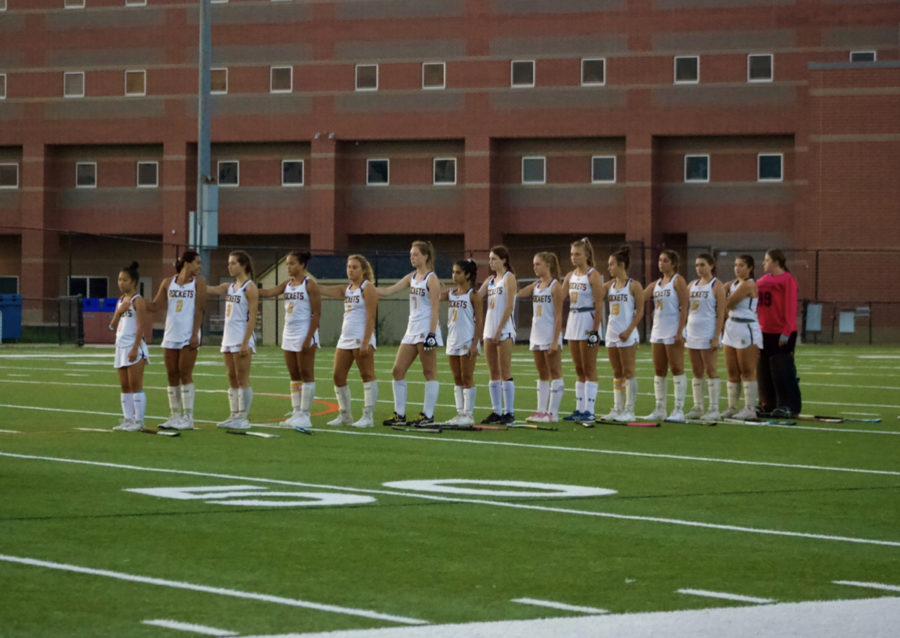Fifty years later Title IX promises are left unmet
RM varsity field hockey team lines up for the playing of the National Anthem at home.
May 15, 2023
There is limited knowledge of what Title IX really means for women in sports. Rather, there is a culture of learned helplessness surrounding women’s sports. Society has been led to the conclusion that there must be some inherent reason why men’s sports deserve and receive more attention. It has become expected that the male teams will get the coveted after school practice time, experienced coaches, and a forgiving budget. These ideas are further bolstered by the everso popular game of football which is heavily ingrained in American culture. It is normal for girls teams to be forced to give up the turf field during their allotted time for practice since the football team wants to use it. When the girls team wins a game they are lucky if they get a shout out on Twitter, versus when the football teams score a single touchdown they are celebrated like they won the Super Bowl. This outpour of support and spirit for the men’s sports comes from the sexism that is ingrained in sports culture.
“Football is definitely the sport that draws in the most attention and resources during the fall. I don’t always think we get the recognition we deserve,” JV field hockey coach Samantha Griffin said. “I know that this problem isn’t unique to RM sports. In our everyday culture we don’t always place value on women in sports.”
The argument isn’t that football and boys athletics shouldn’t be celebrated, it’s that there is an overtly present disparity between which teams get supported versus which don’t. Even with these seemingly obvious disparities that exist, there is an information gap between student-athletes and their rights. And this lack of knowledge is a key component in allowing these inequities to continue. A national poll conducted by the University of Maryland-Ipsos found that 58% of parents and 71% of students knew nothing about Title IX.
Title IX is frequently mentioned in the media and in legal settings, yet many people do not know how the law affects them. Title IX requires all educational institutions in the US to reward male and female athletes equally. This is not saying every team should be rewarded the same amount of support, rather every team should have fair access to comparable sports specific resources. It ensures the prevention of discrimination when it comes to accessing sports facilities, training centers, and equipment.
Title IX has helped to narrow the participation gap in high school athletics participation, with girls accounting for 43% of all high school athletes. However, nearly half of the student athlete population is continuously neglected by school administration. Across the country, boys’ teams have nicer uniforms, access to better playing facilities, experienced coaching staff, and preferred practice times.
“We don’t draw the same attention as bigger and more male dominated sports so we have always had to kind of figure out things for ourselves,” Coach Griffin said.
According to findings from the National Women’s Law Center, nearly 28% of public high-schools in the US are reported to be in violation of Title IX. Though these violations often go unnoticed as found by a USA Today investigation, the Office for Civil Rights only half-heartedly tries to nudge schools to compliance through monitoring which drags the process on for years. This inaction stems from the disheartening reality that there are too few employees to handle the ever increasing caseloads.
“It’s not okay that the Department of Education allows this to happen,” Massachusetts representative Lori Trahan told USA Today in an interview. “Because the status quo just isn’t working for so many women athletes.”
It has become the norm for women’s teams to be too often left to their own devices. School sports are supposed to be an outlet for student-athletes to proudly represent their schools. However, it is hard to feel school spirited when the stands are empty. It is unfair to be forced to play in a skirt that is too short and comes with many unwanted stares. It has become almost normal to hear belittling comments because for some unknown reason women’s sports have been perceived as much easier to play. There has been the acceptance of sex based discrimination in sports as there is absolutely no legal enforcement.
In the 50 years of enactment, Title IX has opened opportunities for girls and women in various areas of sports. However, there is still a significant amount of growth needed. And that starts at the individual school level where administration and athletic departments need to be held accountable for disparities between sports. A safe, open athletic environment is necessary to ensure that athletes and coaches can have conversations about potential violations. Female athletes’ demands have been overlooked for far too long. It is time for people to open their eyes to the work that still needs to be done to level the playing field.



